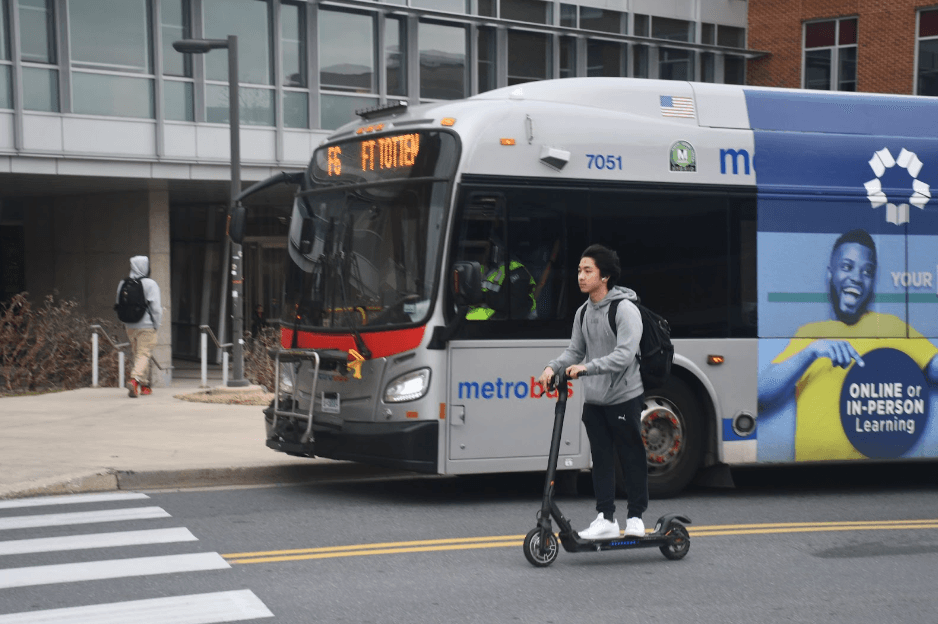First published May 9, 2023 in Stories Beneath the Shell.
by Olivia Borgula
The University of Maryland has launched an educational campaign to decrease unsafe riding practices. But a student group says this campaign will do little to prevent danger for micromobility users.
University vice president Carlo Colella and a team of students and staff called the Tiger Team launched the campaign on Feb. 6 following what the university says is an increase in the number of in micromobility vehicles, including scooters, bikes and skateboards.
The university’s campaign, entitled “Safety Starts with You”, shares educational materials about micromobility on campus. Implementing safer micromobility infrastructure would be more effective, argues Terps for Bike Lanes, a group that aims to increase the number of bike lanes on campus.
Colella’s campus-wide email noted that university has put nearly 400 shared lane markings, called sharrows, on campus streets, installed additional signs near roadways to increase awareness of micromobility vehicles on the road and created pavement markings telling scooter operators and bikers to dismount and walk on the sidewalk.
“The serious concerns that surfaced this academic year required immediate measures, such as the education campaign currently underway and road signs and markings that are being placed,” the university’s Department of Transportation Services said in a statement to Stories Beneath the Shell.
Maryland State law regulates scooter operators under the same code that regulates cyclists. Users of these micromobility vehicles have to ride on the road and follow all traffic laws.
Freshman neuroscience major Lucia Larrea, who rides a GoTrax scooter daily to all her classes, said she agrees that micromobility riders should ride on the street since they can match a car’s speed. But, she said, it’s often more dangerous on the road, especially when riding at night.
“It’s very hard for cars to see you, especially on intersections,” Larrea said.
Cyclists and micromobility users face a difficult choice, she said, because many don’t feel comfortable riding on the road so many ride on the sidewalk. But riding on the sidewalk means having to navigate around pedestrians on a sidewalk — less than ideal.
Collela’s letter focused on a different danger — the “rising number of instances of e-scooters zigzagging around pedestrians or vehicular traffic in busy areas, or getting in accidents.” Headphone use while riding has sometimes played a role in increased danger for micromobility users, the quiz description says.
This university does not keep data on the number of micromobility-involved traffic accidents, according to its records custodian and the university did not respond to an email inquiring where this data came from.
John Evans, director of data analysis at Terps for Bike Lanes, said the solution is not to punish riders, but to design a campus that prioritizes micromobility users over drivers.
“Safety campaigns such as this have very little actual impact on improved safety for students,” he said, referencing a study by the World Health Organization.
The study concludes that there is insufficient evidence that cyclist education and training as well as “communication programmes” reduce cyclist death and injuries. Bike lanes separated from car traffic, mandatory bike lights, helmets and having cars and other vehicles slow to roughly 18 mph, though, are proven methods that reduce deaths and serious injuries of cyclists, the study says.
“There’s a lot of space that could be easily adapted to micromobility infrastructure without a lot of construction time,” Evans said. “Those things would be a lot faster, a lot more easy to implement, and I think would have a strong impact.”
According to Terps for Bike Lanes’ letter, the university has talked about adding bike lanes as long ago as 2011, but has not acted on building the “coherent network of micromobility infrastructure.”
But that might change soon. The Department of Transportation Service’s statement to Stories Beneath the Shell said that the university received a grant to study adding bike lanes to the campus. Evans said the organization is also working with the SGA to propose a bill to implement infrastructure like temporary bike lanes.
The university is also planning a 10-foot-wide bike lane to run alongside the Purple Line as it winds through campus, but that construction won’t finish until late 2026. Installing temporary pop-up bike lanes during the Purple Line construction would make riding in the road safer for micromobility users, Evans said.
Evans said some people Terps for Bikes Lanes have met with were open to implementing change, but there are still improvements to be made.
“I think that some people in DOTS, the ones that we have met with, are receptive,” he said. “But we’re pretty upset with the lack of a comprehensive plan, the lack of supportive language from the administration, and the lack of any admission that infrastructure is necessary.”


Leave a Reply